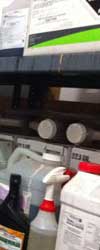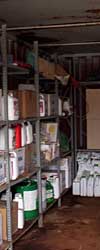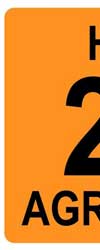Managing an Agrichemical Store
You are under a
legal obligation to actively manage your store.
One of the General Duties under the Hazardous Substances Regulations 2017 is to maintain an inventory of hazardous substances - this will help you manage your agrichemical store appropriately.
The main issues to consider to ensure your store is compliant are:
Segregation

Segregation is important for safety reasons.
- Keep herbicides as far away as possible from fungicides and insecticides
- Keep fumigants in their own area
- Keep powder, liquid, and aerosol formulations separate
- Store powder above liquids
- Group highly toxic and dangerous products that are tracked substances (ie. 6.1A, B) together under lock and key.
Additionally, segregation
- makes stocktaking easier and more accurate
- makes it easier to achieve a 'first-in/first-out' approach to selecting which container of a given product to use.
 |
Prior to 1 December 2017, class 6.1C products were also tracked substances. |
Storage

- Every product in the store must be in a proper container and every container in the store should have a correct and legible label
- Use the oldest products first ('first in/first out'). A good way to achieve this is to write the date on each container when it first enters your store
- Store large (20-60 litre) liquid containers on or near floor level
- Store cartons and paper bags on pallets or shelves away from exterior walls (concrete floors and exterior walls may sweat)
- Store all products so that their labels can be seen
- Avoid risks of cross-contamination, explosion or fire by not storing fertilisers, fuels or lubricants, pool chemicals, seeds or feedstuffs in the same store as your agrichemicals
- Keep the store tidy and free of rubbish at all times. Use Agrecovery (see Disposal) to get rid of empty containers.
Do not keep in your agrichemical store:
- Seeds or feedstuffs (to avoid risks of cross-contamination)
- Fertilisers or pool chemicals (to avoid risks of explosion)
- Fuels or lubricants (to avoid risks of fire).
Emergency preparedness

You should have:
- Some way of dealing with any spillage immediately and safely e.g.
- a supply of dry soil, or
- zeolite mineral sponge (or similar absorbent material, but not sawdust as it is flammable)
- a broom and shovel
- heavy-duty plastic bags
- a drum into which contaminated material or leaking containers can be placed
- secondary bunding may be required depending on the substance and the amount stored at any one time.
- A fire extinguisher (rated at least 30B) readily available
- A clearly visible sign or poster that tells people what to do and who to call if something goes wrong (e.g. doctor, hospital, Poisons Centre)
- A First Aid kit - including an eye bath - should be provided close to the store.
 |
Specifications for fire extinguishers have changed to align with the Australasian standard for portable fire extinguishers. |
Location Compliance Certificate (LCC)

You may need to have a location compliance certificate (LCC) to demonstrate your risk management and emergency preparedness, if you store large quantities of flammable, highly toxic or corrosive products.
LCCs are obtained from a Test Certifier and require a site visit.
| Hazard |
Classification Quantity Beyond which LCTC is Required |
| 3.1A |
20 L |
| 3.1B |
50 L in containers > 5 L |
|
250 L in containers up to and including 5 L |
| 3.1C |
500 L in containers > 5 L |
| |
1500 L in containers up to and including 5 L |
| 5.1.1A |
5 L/kg (use) |
| |
50 L/kg (all packages closed at all times) |
| 5.1.1B |
50 L/kg (use) |
| |
500 L/kg (all packages closed at all times) |
| 5.1.1C |
100 L/kg (use) |
| |
1,000 L/kg (all packages closed at all times) |
| 6.1A |
50 kg/L |
| |
100 kg/L on farms >4ha |
| 6.1B |
250 kg/L |
| |
500 kg/L on farms >4ha |
| 6.1C |
1000 kg/L |
| |
3,500 kg/L on farms >4ha |
| 8.2A |
50 L/kg |
| |
500 kg/L on farm >4ha |
| 8.2B |
250 L/kg |
| |
3,500 kg/L on farm >4ha |
 |
Note: there are exemptions for fuel: petrol and diiesel. |
 |
Highly corrosive and toxic products have been added to the list of hazardous substances requiring this control.
This control was previously known as the Location Test Certificate (LTC),
These new rules requiring a Location Compliance Certificate do not take effect until 1 December 2019. |
If you require an LCC, then from 1 December 2019 you may need to comply with additional storage requirements such as provision of a safety shower if containers are opened in the store, or two entrances if store is larger than 25m2.
 |
More information can be found in WorkSafe's Quick Guide to Storing class 6 & 8 hazardous substances.
|
Other equipment

- A sturdy bench or table in the store is useful for the measuring and mixing of products
- A scoop, scales, calibrated jugs and buckets for measuring products in the store (and keep these in the store, not in the smoko room or kitchen!)
- Personal protective equipment (PPE) should not be kept in the store. A minimum of PVC nitrile gloves, overalls, and face and eye protection should be kept in a separate clean area or cabinet
- Store respirator canisters in air tight containers in the cabinet with PPE
- A clean water supply is needed for washing hands, rinsing, and clean up.